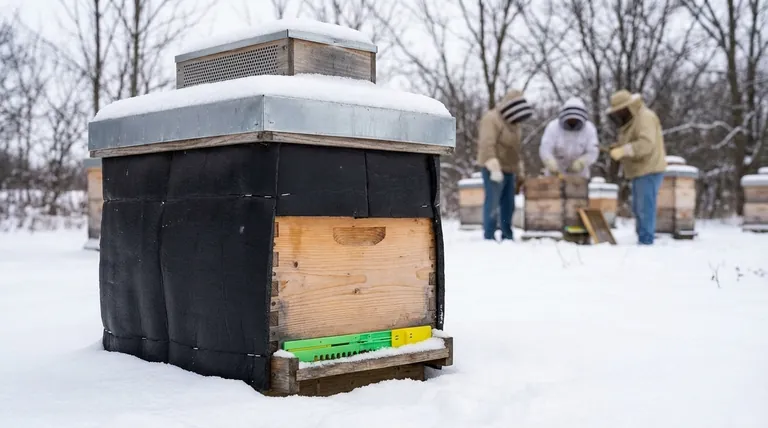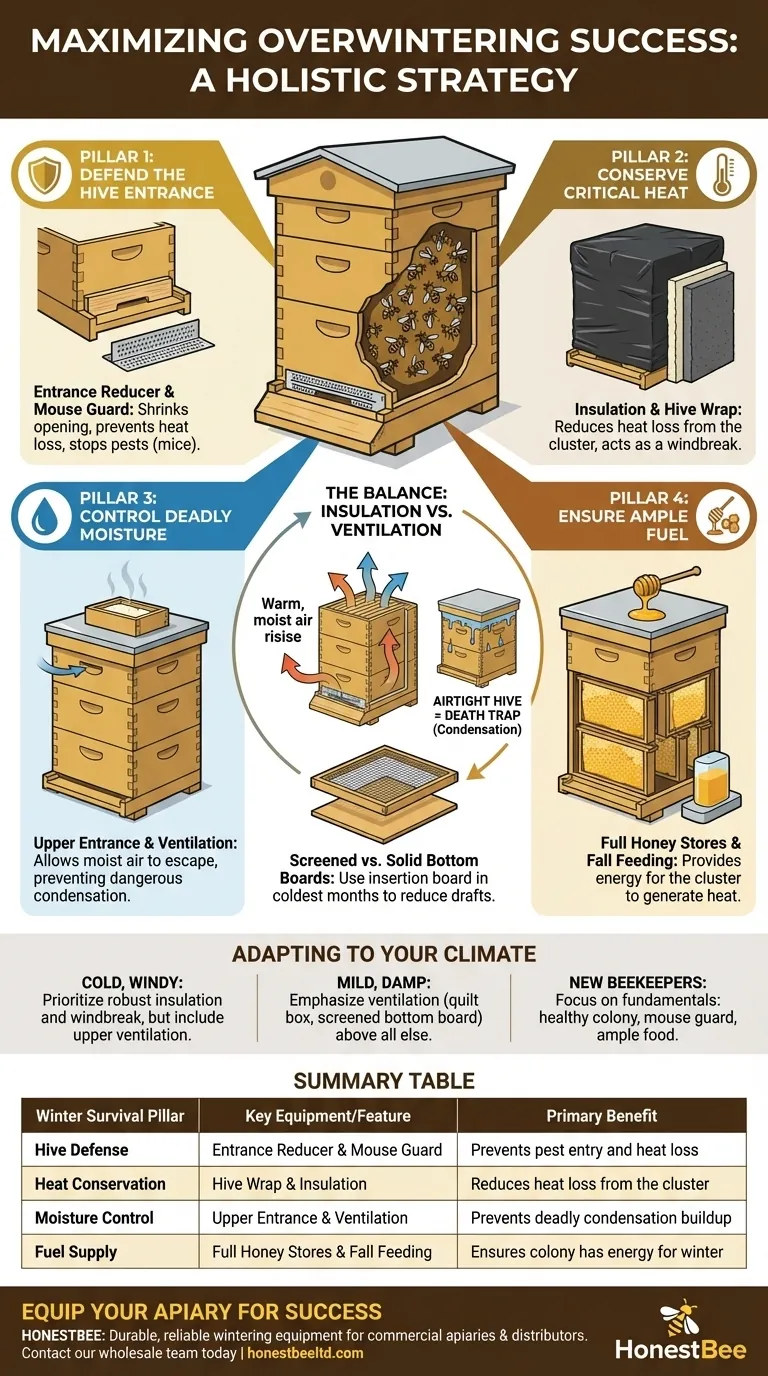Beyond a simple wrap, one of the most critical and often overlooked features for improving overwintering success is a properly installed entrance reducer and mouse guard. This simple device drastically shrinks the hive opening, which helps the colony defend itself, prevents heat loss, and blocks mice from seeking shelter and destroying the comb.
Successful overwintering is not about a single gadget, but about a holistic strategy. You must manage the interconnected challenges of heat retention, moisture control, and hive defense to give your colony its best chance of survival.

The Pillars of Winter Hive Survival
A colony's winter survival depends on its ability to manage its internal environment against the external cold. Every piece of equipment and every management decision should support four key goals.
Principle 1: Defend the Hive Entrance
A winter cluster is smaller and slower, making it vulnerable. A wide-open entrance is a significant liability.
An entrance reducer shrinks the opening to a small notch, giving the colony a tiny, defensible space. This minimizes robbing from stronger hives and prevents pests from entering.
Most importantly, a mouse guard (often a metal piece with bee-sized holes) is non-negotiable. A single mouse can quickly destroy a hive by eating honey, pollen, and brood, leaving the colony to starve.
Principle 2: Conserve Critical Heat
Bees do not heat the hive; they heat their cluster. Your job is to minimize how much of that precious heat is lost to the environment.
Insulation is key. While bees are adapted to natural cavities, a standard wooden hive has thin walls. Adding rigid foam insulation or a hive wrap reduces the rate of heat loss.
A hive wrap, often black plastic, serves a dual purpose. It acts as a windbreak, stopping cold drafts from penetrating cracks, and it absorbs solar radiation to provide a small amount of warmth on sunny days.
Principle 3: Control Deadly Moisture
Moisture, not cold, is the primary killer of colonies. The bees' respiration releases warm, moist air. If this air hits a cold inner cover, it condenses and drips back down, chilling and killing the cluster.
Ventilation is the solution. Providing a small upper entrance or ventilation port allows this moist air to escape. Warm, humid air naturally rises, so creating an exit at the top of the hive is the most effective way to vent it.
A quilt box or a reliable hive cover designed to absorb or redirect condensation can also be a game-changer, especially in damp climates.
Principle 4: Ensure Ample Fuel
The bees' winter cluster generates heat by vibrating their wing muscles, a process that consumes significant energy. Their sole fuel source is their stored honey.
Before winter, you must ensure the colony has a full hive of honey. If their natural stores are insufficient, you must feed them with sugar syrup in the fall until they have enough weight to last until the first spring nectar flow.
Understanding the Trade-offs: Insulation vs. Ventilation
The most common mistake beekeepers make is failing to balance the need for insulation with the need for ventilation. This balance is the core challenge of overwintering.
The Dangers of an Airtight Hive
If you heavily insulate a hive but fail to provide an upper exit for moisture, you create a death trap. The insulation keeps the interior surfaces cold, causing massive condensation. A wet colony is a dead colony, no matter how well-fed or insulated it is.
Screened vs. Solid Bottom Boards
A screened bottom board provides excellent ventilation and helps control Varroa mites. However, in very cold climates, the constant draft can stress the colony and force them to consume more honey.
Many beekeepers slide a solid board (or "insertion board") under the screen during the coldest months. This reduces the draft while still allowing moisture control via the upper entrance. Using a slatted rack above the bottom board can also provide a buffer zone of dead air, giving the bees a space away from the immediate draft of the entrance.
Making the Right Choice for Your Climate
Your overwintering strategy must be adapted to your local conditions. There is no one-size-fits-all solution.
- If your primary focus is surviving a cold, windy climate: Prioritize robust insulation and a solid windbreak, but never forget to include a small upper entrance for moisture release.
- If your primary focus is navigating a mild, damp climate: Emphasize ventilation and moisture control above all else. A quilt box and a screened bottom board (perhaps partially open) are your best tools.
- If you are a new beekeeper: Master the fundamentals first. Ensure your colony is strong and healthy in the fall, provide a mouse guard, and verify they have more than enough food stores to last the winter.
Ultimately, successful wintering is the result of proactive management that addresses the colony's fundamental needs for warmth, dryness, and security.
Summary Table:
| Winter Survival Pillar | Key Equipment/Feature | Primary Benefit |
|---|---|---|
| Hive Defense | Entrance Reducer & Mouse Guard | Prevents pest entry and heat loss |
| Heat Conservation | Hive Wrap & Insulation | Reduces heat loss from the cluster |
| Moisture Control | Upper Entrance & Ventilation | Prevents deadly condensation buildup |
| Fuel Supply | Full Honey Stores & Fall Feeding | Ensures colony has energy for winter |
Ready to equip your apiary for winter success?
At HONESTBEE, we supply commercial apiaries and beekeeping equipment distributors with the durable, reliable wintering equipment your operation needs. From industrial-grade entrance reducers and heavy-duty mouse guards to professional insulation wraps and ventilation systems, our wholesale-focused operations ensure you get the right tools at scale.
Give your colonies their best chance of survival. Contact our wholesale team today to discuss your winter equipment needs and volume pricing.
Visual Guide

Related Products
- Multi-Functional Sliding Hive Entrance for Beekeeping
- Professional Hive Front Entrance Bee Feeder
- Boardman Entrance Bee Feeder Durable Galvanized Steel and Wood Construction for Beekeeping
- Classic Boardman Entrance Bee Feeder Hive Front Feeding Solution
- Multi-Functional Rotary Hive Entrance Disc for Beekeeping
People Also Ask
- How does the sliding design of the entrance reducer benefit beekeepers? Achieve Ultimate Hive Control
- What are some alternative strategies to using entrance reducers? Empower Your Bees for Natural Hive Defense
- What additional functions do hive entrances serve? A Key to Colony Health, Security, and Productivity
- What size is the entrance hole in a native bee hive? The 13mm Standard for a Thriving Colony
- How does entrance configuration vary seasonally for beekeepers? A Guide to Year-Round Hive Health



















